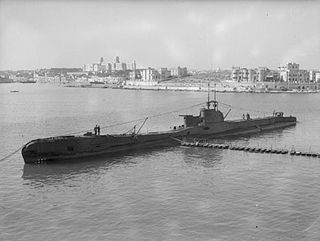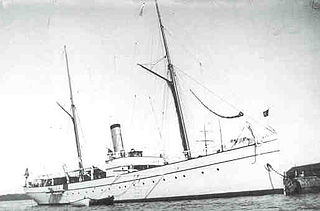
HMS Taku was a British T class submarine built by Cammell Laird, Birkenhead. She was laid down on 18 November 1937 and was commissioned on 3 October 1940.

HMS Tigris was a T-class submarine of the Royal Navy. She was laid down at Chatham Dockyard and launched in October 1939.

HNoMS Heimdal was a Norwegian warship built at Akers mekaniske verksted in Kristiania, Norway in 1892 with build number 137.

USS West Ekonk (ID-3313) was a cargo ship for the United States Navy during World War I. She was later known as SS West Ekonk in civilian service under American registry, and as SS Empire Wildebeeste under British registry.
SS Empire Advocate was a 5,787 ton steamship which was built in 1913 as the Solfels. She was taken as war reparations in 1919 and renamed Bowes Castle in 1920. In 1932 she was sold to Italy, being renamed Angelina Lauro, being seized in 1940 and renamed Empire Advocate. She was scrapped at Bo'ness in 1945.
British Dragoon was a 9,909 ton tanker which was built as Empire Alliance in 1943. She was renamed British Dragoon in 1945, and scrapped in 1962.

SS Ocean Vigour was a British Ocean class freighter, which served on various convoys during World War II, and then as a troopship before being used to deport illegal Jewish immigrants who attempted to enter Mandate Palestine to internment camps in Cyprus. She took part in the return of immigrants from the SS Exodus back to Europe, before being sold into commercial service. She was scrapped in 1967.
British Cavalier was a 9,891 GRT tanker that was built in 1942 for the Ministry of War Transport (MoWT) as Empire Cavalier. In 1945, she was sold to the British Tanker Co Ltd and renamed British Cavalier, serving until 1959 when she was scrapped.
Belgian Captain was a 7,041 GRT cargo ship which was built in 1942 as Empire Centaur for the Ministry of War Transport (MoWT). In 1943 she was passed to the Belgian Government and renamed Belgian Captain. Postwar, she was sold into merchant service and renamed Capitaine Lambe. In 1960 she was sold to Hong Kong and renamed Ardee, being renamed Alpha Trader in 1964. She served until 1967 when she was scrapped.

Polar Chief was an 8,040 GRT tanker which was built in 1897 as the cargo ship Montcalm. In 1914 she was requisitioned by the Admiralty, serving initially as a troopship. In October 1914, she was converted to a dummy battleship and renamed HMS Audacious. In 1915 she became a depot ship, followed by conversion to a tanker in 1916 when she was sold into Royal Fleet Auxiliary service and renamed RFA Crenella. In 1917, she survived a torpedo attack off the coast of Ireland. In 1919, she was sold into merchant service as SS Crenella.

Inkosi was a 6,618 GRT refrigerated cargo liner which was built by Swan, Hunter & Wigham Richardson Ltd, Newcastle upon Tyne for the Ministry of War Transport (MoWT). She was hired by the Royal Navy in 1940 for use as an ocean boarding vessel, but was sunk in an air raid before she could be used for this purpose. The ship was salvaged, converted to a cargo ship and passed to the Ministry of War Transport (MoWT), who renamed her Empire Chivalry. In 1946 she was sold and renamed Planter. She served until 1958, when she was scrapped.
Belgian Crew was a 7,048 GRT cargo ship which was built in 1942 by Sir W G Armstrong, Whitworth & Co (Shipbuilders) Ltd, Newcastle upon Tyne as Empire Claymore for the Ministry of War Transport (MoWT). She was transferred to the Belgian Government in 1943 and renamed Belgian Crew. In 1946 she was sold to Compagnie Maritime Belge and renamed Capitaine Parlet. In 1960 she was sold to Hong Kong and renamed Ardenode. A further sale to Panama in 1966 resulted in her being renamed Tynlee. She served until 1969, when she was scrapped.
SS Empire Cobbett was a 9,811 GRT tanker which was built in 1942 by Furness Shipbuilding Co Ltd, Haverton Hill-on-Tees for the Ministry of War Transport (MoWT). In 1946 she was sold into merchant service and renamed San Wilfrido. She was scrapped in 1959.
Empire Coleridge was a 9,811 GRT tanker which was built in 1942 by Sir J Laing & Sons Ltd, Sunderland for the Ministry of War Transport (MoWT). In 1946 she was sold into merchant service and renamed Esso Cheyenne. She was scrapped in 1961.
SS Vigrid was a Norwegian steam-powered cargo ship built in 1915. Sailing during the First World War, she was torpedoed and sunk without warning by a German U-boat on 31 December 1917.
Kollbjørg was a 8,236 GRT tanker that was built in 1941 as Empire Diamond by Harland & Wolff, Belfast, United Kingdom for the Ministry of War Transport (MoWT). She was transferred to the Norwegian Government in 1942 and renamed Norsol. In 1946 she was sold into merchant service and renamed Kollbjørg. A sale to Sweden in 1956 saw her renamed Storo, she served until 1959 when she was scrapped.
Empire Dorado was a 5,595 GRT design 1019 cargo ship that was built in 1920 as Tolosa by Atlantic Corporation, Portsmouth, New Hampshire, United States for the United States Shipping Board (USSB), passing to the United States Maritime Commission (USMC) in 1937. She was sold to the United Kingdom in 1940, passed to the Ministry of War Transport (MoWT) and renamed Empire Dominica. She served until November 1941, when she was in collision with another ship. Although taken in tow, she subsequently sank.
Norlom was a 6,326 GRT Design 1105 cargo ship that was built in 1919 as Editor by Skinner & Eddy Corporation, Seattle, Washington, United States for the United States Shipping Board (USSB), which became the United States Maritime Commission (USMC) in 1937. In 1941, she was transferred to the British Ministry of War Transport (MoWT) and renamed Empire Dunlin. She was transferred to Norway in 1942 and renamed Norlom. She served until 2 December 1943 when she was bombed and sunk at Bari, Italy.

Spichern was a motor tanker that was built in Denmark for Norwegian owners and launched in 1935 as Krossfonn. In 1940 the German navy captured her, renamed her Spichern and converted her into an oiler. In 1944 she was damaged in an air raid and then scuttled.








